Of all the behavioral modification tools at a modern dog owner’s disposal, perhaps none are more controversial than choke chains, pinch collars, and similar scary-looking products.
Viewing these items are cruel or dangerous, many owners and dogs shy away. But are these tools truly cruel? Or are they effective training tools that can help your dog?
We’ll explore the issue in detail here and help you decide whether prong and pinch collars are good options for you.
Please note that this article has been updated to match with K9 of Mine’s revised philosophy regarding prong and chain collars. We do not endorse or encourage the use of these tools.
Are Choke Collars Safe? Should I Use Aversives in Training?
Choke and prong collars are controversial because they are classified as aversive tools.
An aversive tool is one that uses pain to diminish a behavior. Aversives are based on the positive punishment quadrant of learning, in which the trainer adds an unpleasant stimulus to punish (aka reduce) an unwanted behavior.
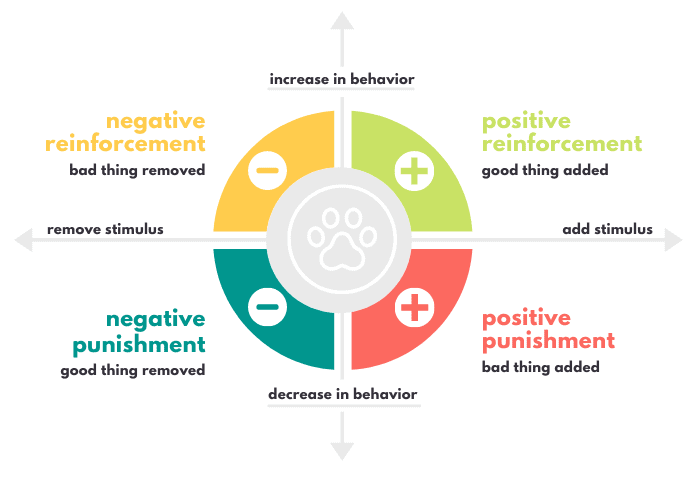
The issue is, many modern dog trainers no longer support the use of aversives and positive punishment in dog training. There are a few reasons why this trend is growing.
How our empathy for animals reflects acquired empathy for children
For one, as our society’s empathy for animals grows, we feel less comfortable inflicting pain on our companion animals.
Dogs share our homes and many times our beds. They are considered part of the family. We value their feelings and experience, and want them to have a positive relationship with us.
Our society’s evolution of feeling in relationship to animals mirrors our progress of understanding children as well.
It wasn’t so long ago that the concept of “childhood” didn’t even exist, and children were expected to work and earn their keep like any adult. The concept of child psychology, the individual experience of children, and the idea that as a society we should protect children is fairly novel, with pediatric psychology only becoming popularized in the mid-1900s.
It was once commonplace to spank children or “whip out the belt” when a child misbehaved. Most parents no longer consider this a suitable child-rearing strategy because they realize that using these fear-based intimidation strategies can damage their relationship with their offspring.
The same applies to dogs!
The dangers of using fear and intimidation to control behavior
Using punishment can have an outward desired effect on a dog’s behavior, just as beating a child for sneaking out at night may prevent the behavior from repeating.
But does that make it a good option?
Morality aside, resorting to fear and intimidation to manage anyone’s behavior – whether in relation to a pet, child, or partner – generally does not bode well. Any relationship based on fear is a stunted and broken one. It results in a relationship grown from seeds of distrust and hurt.
That being said, pain and intimidation can deliver outward results. And for owners who simply want a robot-like dog who does A, B, and C when commanded, aversives can deliver.
This is why the debate around aversives is so confusing and messy between trainers – ultimately, it comes down to a different expectation of success.
Prong collars offer a shallow facade of training success
If you categorize success as a trusting, bonded relationship with your dog who you help navigate the human world confidently, then aversives like prong collars and choke collars should not be part of your training.
However, if your dog’s relationship and feelings towards you is irrelevant to you, and all you care about are outward demonstrations of control, aversives can work quite well.
And indeed, trainers who utilize tools like e-collars, choke collars, and prong collars can change a dog’s outward behavior in minutes. To many stressed owners with dogs exhibiting problem behaviors, these tools can feel like a miracle.
These results can feel too good to be true – and in fact, they are. At least in some sense.
Trainers who use aversive tools like choke and prong collars are not doing any kind of real behavior modification, and instead are suppressing behavior.
What is behavior suppression?
Behavior suppression is a term used when a dog shuts down emotionally. Fear of punishment and pain can make a dog subdued – a bit like when a human disassociates from a particularly upsetting experience.
Behavior suppression does stop the problem behavior from occuring, but it does not teach the dog what to do instead. The dog chokes down their fear and anxiety, never learning how to cope with the issue at hand. A dog can continue like this for some time, but eventually, fallout occurs.
This fallout can be subtle and even unperceived by humans, such as a dog simply not taking joy in your presence and avoiding you. Or it can be more substantial, like a dog snapping seemingly “out of nowhere” when they simply can’t handle the stress any longer.
Do you value your relationship with your dog?
In today’s culture, we tend to value communication, empathy, and relationships more than previous generations. Outward symbols of success ring hollow to many, as more people recognize connections to others as more fulfilling than token achievements.
This is why many of us would rather develop a positive relationship with our dogs and using positive reinforcement to train rather than aversives.
Most of us care how our dogs feel about us. But not everyone will.
I don’t support aversives, but I understand why some people use them
Using aversives like prong and choke collars in dog training is risky. These pieces of equipment can have some serious repercussions and damage your dog’s bond with you.
However, I also know how excruciating it can be to have a dog with serious behavior problems.
As an owner of a rescue dog who once had some troubling aggressive behaviors that took a dramatic toll on my emotional wellbeing, I understand the stress, frustration, and fear that can happen when dealing with a problem dog.
I myself was probably a month away from resorting to aversives with Remy until I finally started to see some progress with our force-free centered training.
While I would always recommend that owners utilize force-free methods and positive, reward-based training, some owners may already be at their breaking point and about to give up.
When you’re dealing with dog behavior that is putting you or your family in danger and have already attempted several strategies without success, sometimes it can feel like resorting to an aversive tool to suppress behavior is the only option on the table.
When you’re at that point where you need to see change fast or you’ll need to surrender or euthanize your dog, I can understand resorting to aversives.
If at all possible, I’d suggest seeking out a force-free, positive-based trainer (or, if you’re dealing with aggression issues, you really need a certified animal behavior consultant or a veterinary behaviorist).
However, I know some people will require the quick and easy path, even if it has dangerous repercussions. If you are going to use these tools, we’ll discuss how to use them appropriately and safely below.
What Is a Dog Choke Chain and How Does it Work?
A choke chain (also known as a choke collar or chain collar) is a very simple device consisting of a length of chain and two big rings attached to either end.
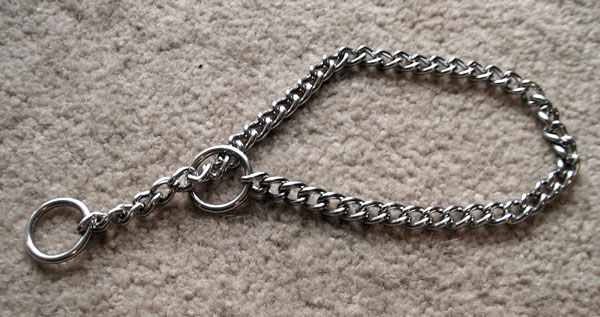
After setting it up properly (we’ll discuss this in a minute), you can slip it over your dog’s head and attach it to your favorite dog leash.
Chain collars are generally used for:
- Keeping your dog’s head up and attention on you while walking at your side
- Delivering a sharp correction when your dog exhibits an undesirable behavior (such as lunging and barking at another dog)
- Correcting your dog for breaking away from the “heel” position.
They are also often implemented to stop dogs from dragging their owners all over the neighborhood. However, there are better ways to teach a dog to loose leash walk than through corrections.
How Do Chain Collars Work?
When used as intended, chain collars should not be strangling or choking your dog. A chain collar might be better labeled as a “correction collar” since its design is purposefully intended to make it easy to deliver a squeezing sensation on the neck as a physical correction.
This works through leverage and body mechanics – when used properly, the collar sits right up at the base of the dog’s skull, which naturally draws their attention to you when you apply slight pressure. The quick jerk employed in a correction tightens the chain for a split second, before returning it to a loose state.
As detailed above, using aversive tools and issuing positive punishment via physical corrections in training can have some serious negative consequences. Some owners consider the use of corrections worth the potential drawback, but others do not. Weigh for yourself if incorporating corrections into your training is worth the risk.
What Are Prong Collars and How Do They Differ from Choke Collars?
Prong or pinch collars are pretty insane-looking devices that resemble something you’d expect to see in a horror movie.
They are essentially chain-based collars that feature a number of inward-pointing prongs.
When not under tension, the prongs simply rest around your dog’s fur; when a correction is made, the collar tightens, causing the prongs to press into the dog’s neck.
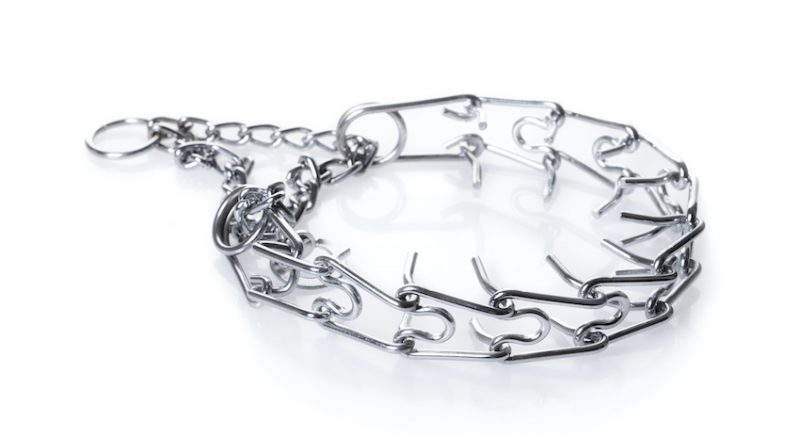
Advocates for prong collars claim that this device is actually safer than a standard flat collar, since the prongs help ensure that the force of the correction is applied across a number of different locations at the same time. However, this equalized pressure theory is up for debate.
The prongs of most collars are blunt or rounded to help avoid injuring your dog’s neck. But if you like, you can purchase soft vinyl tips to further ensure your dog’s safety.
Prong collars are more popular than choke collars for preventing pulling, since a dog will naturally experience pain when pulling on a prong collar, correcting the behavior without any conscious effort by the owner.
Prong collars are also popular for issuing corrections to a lunging, barking dog on walks (although a primarily correction-based training method is definitely not suitable for reactivity training).
How Do I Put a Choke Chain on My Dog?
Despite the simplicity of the device, many people are stumped when they receive a length of chain with two rings on the end. It’s supposed to be a loop, right? Neither of the terminal rings will pass through the other, so how do you make this into a loop?
While this initially seems like some sort of mind-trick puzzle, it’s actually quite simple:
- Pinch a length of the chain
- Pull the doubled portion all the way through the ring
- Push this pinched portion through either of the rings
- Place the resulting loop around your dog’s head, with the free end (the one you’ll attach to the leash) on top of your dog’s neck
You’ll need to decide the side on which your dog will walk before placing the loop around his head. The free end of the collar should lie across the top portion of your dog’s neck and point towards you. This ensures that when you release tension on the leash, the restrictive ring will slide back down the chain, re-opening the collar.
If you want to put a prong collar on your dog, there’s a slightly different procedure. You’ll need to disconnect two of the links (it’s often easiest to disconnect the two directly opposite the leash ring), then wrap it around your dog’s neck and reattach the links.
As with any new training tool, you’ll want to work a lot on desensitization before taking your dog out on a walk with this tool. Your dog needs to have a positive association with the collar, so you should be dispensing treats repeatedly to your dog when he is wearing the collar.
You’ll also want to start with short practice sessions by putting the collar on, giving treats, and immediately taking it off after 5-10 seconds.
Basic Use of a Choke Chain or Pinch Collar
Improper use of a choke or pinch collar can lead to a host of medical problems. It’s a good idea to seek the help of a trainer who is experienced using these tools to ensure you are using them safely, but the basic procedure is as follows:
- Place the collar on your dog in the correct orientation.
- Praise your precious puppy and reward him for wearing this odd contraption.
- Take your dog on a walk. Once your dog has been desensitized to the tool indoors and does not display any fearful body language wearing the device indoors, you can begin going out on walks with it!
- If dog reacts to trigger, pop the leash quickly — Many like to issue a verbal correction at the same time.
- Refocus the dog’s attention to you. Once the dog has refocused on you, engage with praise and treats to encourage attention on you while ignoring the trigger.
This is technically how you would use a choke or prong collar to correct a dog’s reactive behavior. However, this is not the strategy we recommend at K9 of Mine, and there is a lot more an owner must do when training with a reactive dog.
Do Choke and Prong Collars Hurt?
Yes.
Trainers love to debate semantics and say that prong collars don’t really hurt, they just emit mild discomfort. But the long and short of it is yes, these tools do hurt. They use pain to suppress unwanted behavior. If they were not painful, they would not work!
Don’t forget that even mild pain, repeated over and over again, can greatly increase an individual’s stress. As a good human comparison, you might think of someone flicking your ear. It certainly isn’t pleasant, but it isn’t agonizing pain.
But, if someone flicked your ear over and over again, it would start to really upset you and stress you out. You probably wouldn’t have such fond feelings about the person flicking your ear. You might become more scared and anxious, wondering when the next ear flicking will occur.
This is why research studies have shown elevated stress levels in dogs who are trained with aversive tools vs those who are not.
The Dos and Don’ts of Choke Chains and Other Pinch Collars
When using a pinch or chain collar, be sure to do the following things:
Be sure that you put the chain collar on your dog in the appropriate orientation. If you walk with the dog on your right, leash-end of the chain should hang from the left side of your dog’s neck, and it should look like a lower-case “q” when you put it on your dog’s neck. Reverse these directions if your dog walks on your left, and be sure the chain looks like a lower-case “p” when you put it on.
Try to keep chain and pinch collars high on your dog’s neck, just below the jaw. This can take a little practice to get right, but it is important for avoiding injuries. Some corrective collars feature leather tabs or similar devices that make it easier to keep the collar from slipping down your dog’s neck.
Ensure that you are using a chain collar of the appropriate length. Most trainers and vets recommend measuring the circumference of your dog’s neck carefully, with a flexible ruler or measuring tape. Then, add about 4 or 5 inches to arrive at the proper length for a chain collar.
Conversely, be sure that you don’t do any of the following:
Don’t use a chain collar or similar device as a form of punishment when you’re frustrated with your dog – doing so is not only cruel, it is incredibly counterproductive to your efforts. Chain collars are designed for giving corrections and keeping your dog in the proper position — nothing more.
It is probably wise to avoid using chain or pinch collars with dogs under 6 months of age. In fact, it is probably even wiser to wait until after 1 year of age before using them.
Never use chain collars or other corrective collars with short-nosed or thin-necked breeds. These dogs are simply to fragile to use this training tool, and could easily end up injured. Opt for a good dog harness instead.
Don’t allow your dog to pull against the chain. This can cause serious injuries, including tracheal damage, pulled muscles or even cervical damage. Some dogs can actually exert enough pressure to cause their eyes to bulge. If your dog is constantly pulling on the leash, don’t use a chain or prong collar! Work on your loose leash walking skills and try an anti-pulling harness instead.
Never leave your dog unattended while wearing any type of chain collar. This includes not only prong collars and choke chains, but slip collars and martingales as well.
Martingales and Slip Collars: Alternative Options
Choke chains and pinch collars are not the only game in town, and there are a number of other corrective collars on the market.
Two in particularly wide use include the martingale and the slip collar. Both work in relatively similar ways to chain and prong collars, although there are a few key differences.
Martingales
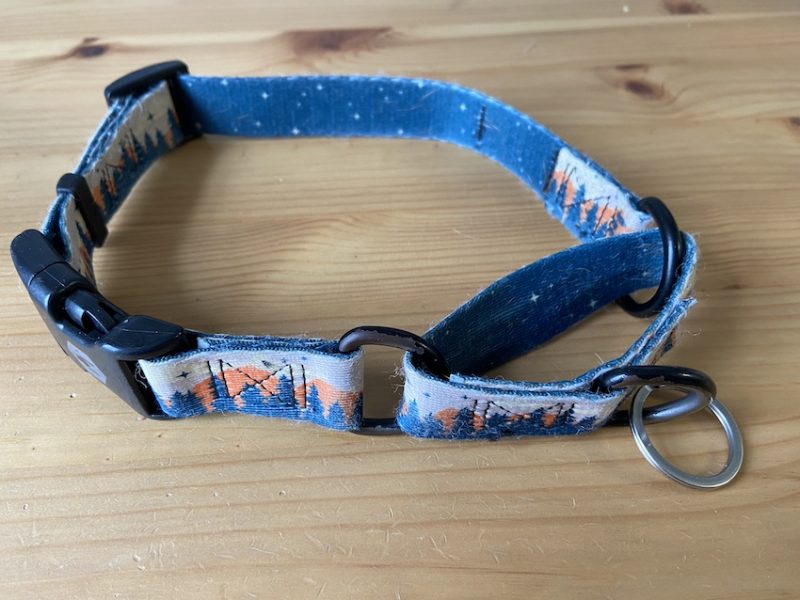
Martingale collars are conceptually similar to prong collars, except that they are primarily made from nylon webbing, rather than metal links, and they have no prongs.
Martingales are often considered the safest type of correction collar to use on a day-in-day-out basis, but there are still risks entailed with such use.
Other owners opt for martingales simply because they prevent a dog from backing out of a collar and getting loose, making them a great choice for Houdini escape artists.
Slip Collars
Slip collars are very similar to chain collar – just replace the chain links with a length of rope and you’ve got a slip collar.
They work in the same way that chain collars do. Many slip collars come with a stopper to keep the collar from opening wider than you’d like.
Best Chain Dog Collars, Prong Collars, and Similar Tools
We’ve compiled a list of the most established brands for chain and prong collars on the market below. Be sure to review the various pros and cons of each, and select the best model for you, your pup, and your training philosophy.
1. Coastal Pet 20-Inch Titan Heavy Chain Collar

About: The Coastal Pet Chain Collar is a straight-forward chain collar, designed to work well without costing a fortune. The combination of heavy-duty, 3-milimeter links and argon-welded seams ensure the chain is durable and built to last.
Features:
- Great-looking chain is chrome-plated, so it will not rust or tarnish over time like some others
- 20-inch-long chain (including end rings)
- Recommended and used by certain trainers
PROS
If you are looking for a no-frills chain collar at a very affordable price, this is a great choice.
CONS
There weren’t many complaints about the Coastal Pet Chain Collar. However, a few dog owners experienced sizing problems, so always be sure to measure your dog’s neck carefully before ordering.
2. Herm Sprenger Fur Saver Heavy Dog Training Collar

About: The Herm Sprenger Fur Saver features a slightly different design than traditional chain collars. Instead of using a large number of short chain links, which often catch the fur of long-haired breeds, the Fur Saver uses a small number of very large links to provide a collar that works well, without tangling Fido’s hair.
Features:
- Made in Germany, this premium chain comes with a quality guarantee
- 19-inch-long chain (including end rings)
- Chrome finish is eye-catching
- Won’t catch, break or pull the hair on your dog’s neck
PROS
Most owners love Fur Saver chain collars, and long-haired dogs certainly prefer the coat-saving design. They are very well made, work smoothly and are built to last. It’s an easy choice if you don’t mind coughing up a few more bucks than you would spend for a typical chain collar.
CONS
Displeased owners who tried the Herm Sprenger Fur Saver were few, as were complaints about the product. It is about twice the price of a typical chain collar, but its quality easily justifies this difference in price.
3. Coastal Pet Prong Collar

About: The Coastal Pet Prong Collar is a straight-forward prong collar that can help accelerate the training process and provide another tool in your training arsenal. Built from the same chrome-plated links and argon-welded seams that their chain collars are, Coastal Pet Prong Collars will not rust, tarnish or break.
Features:
- 20-inch-long chain (total length, end-to-end)
- Includes 11 dual-pronged links
- Prongs can be removed easily to alter the size
PROS
Most customers were quite pleased with the durability and quality of the collar. The fact that you can alter the size is also quite nice.
CONS
Despite being marketed as rust-proof, a very small number of customers living in coastal areas did report some rusting after prolonged use.
4. Herm Sprenger Extra Large Black Stainless Steel Pinch Training Collar

About: The Herm Sprenger Pinch Collar is a premium collar designed to help you train your four-legged bestie. Simply put, this is a beautifully crafted product, made from high-quality materials.
Features:
- 20-inch-long chain (total length, end-to-end)
- Includes 10 premium, dual-pronged links
- Black Anodized finish to ensure the collar will last and look great for years to come
- Made in Germany
PROS
Because the Herm Sprenger Pinch Collar is black rather than chrome, it provides a slightly subtler aesthetic, which appealed to many owners, including police and military K9 handlers, who prefer the black finish for tactical reasons.
CONS
You’ll don’t get this kind of quality without paying for it. But, there were very few complaints about the Herm Sprenger Pinch Collar, and most customers found it to be well-worth the additional cost.
5. Mendota Command Slip Collar

About: The Mendota Command Slip Collar is a soft, flexible alternative to the traditional chain collar. Made from color-fast multifilament, double-stitched polypropylene, it won’t catch your pet’s fur or stain your pet’s skin. The Mendota Slip Collar comes in 10 different great-looking color and pattern options to match your pet’s personality.
Features:
- Available in six different lengths, ranging from 16 to 26 inches
- Trimmed with English bridle oil-tanned leather accents
- Made with non-corrosive, brass-toned rings that look great and last for years
PROS
The vast majority of owners using this collar praised it highly. Many owners (and presumably their dogs) appreciated the ability to use a soft training tool, while still achieving better behavior during leash walks.
CONS
There weren’t many complaints about the Mendota Slip Collar, although a very small number of owners reported that the collar was not as effective for their dog as a chain collar. Nevertheless, most owners found it to work quite well.
6. PetSafe Martingale Collar

About: The PetSafe Martingale Collar is an alternative training tool designed to help improve your dog’s behavior during leash walks. Because Martingale-style collars only close a predetermined amount, they are safer than chain and slip collars.
Features:
- Made from high-quality nylon webbing for a comfortable fit
- Available in five different length and width options
- Comes in five different eye-catching colors to ensure your dog looks great
- Can be operated by hand if need be
PROS
Many noted that their dog seemed to prefer wearing these collars to prong or pinch collars. Additionally, many owners who had dogs that would escape from most other collars could not do so with these.
CONS
There weren’t many complaints from those who used the collars as training tools, but many were unaware that Martingales are not designed to be used outside of training sessions. Also, this specific model is for petite dogs, but there are other similar models for larger dogs as well.
***
Do you use correction collars to help train your dog? How effective have they been for you? Have you tried other methods before resorting to these tools? Share your experience in the comments!





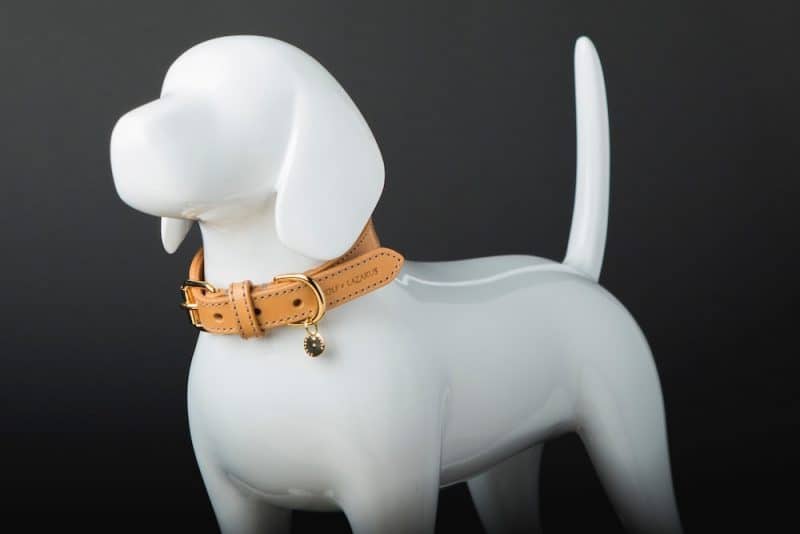


Leave a Comment